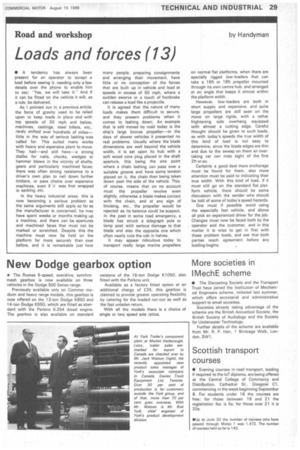Road and workshop
Page 31

If you've noticed an error in this article please click here to report it so we can fix it.
Loads and forces (13)
by Handyman
• A tendency has always been present for an operator to accept a load before seeing it, needing only a few details over the phone to enable him to say: "Yes, we will take it." And if it can be fitted on the vehicle it will, as a rule, be delivered.
As I pointed out in a previous article, the force of gravity used to be relied upon to keep loads in place and with top speeds of 30 mph and below. machines, castings, steel billets, etc., rarely shifted over hundreds of miles— little in the way of serious lashing was called for. This suited many works with heavy and expensive plant to move.
They had—and still have a strong dislike for nails, chocks, wedges or hammer blows in the vicinity of shafts, gears and particularly machined faces; there was often strong resistance to a driver's own plan to nail down further timbers, or pass chains over expensive machines, even if it was first wrapped in sacking. etc.
In the heavy industrial areas, this is now becoming a serious problem as the same arguments still apply so far as the manufacturer is concerned: he may have spent weeks or months making up a machine, and there can be apertures and machined faces that must not be marked or scratched. Despite this the machine must now be held on the platform far more securely than ever before, and it is remarkable just how many people, preparing consignments and arranging their movement, have little or no conception of the forces that are built up in vehicle and load at speeds in excess of 50 mph. where a sudden swerve or a touch of footbrake can release a load like a projectile.
It is agreed that the nature of many loads makes them difficult to secure, and they present problems when it comes to lashing down. An example that is still moved by road today is the ship's large bronze propeller—in the days of slower vehicles it presented no real problems. Usually where the blade dimensions are well beyond the vehicle width, it is sat upon its hub with a soft wood core plug placed in the shaft aperture, this being the one point where a chain lashing can pass over a suitable groove and have some tension placed on it, the chain then being taken down past the side of the vehicle. This, of course, means that on no account must the propeller revolve even slightly, otherwise a blade makes contact with the chain, and at any sign of bruising, etc., the propeller would he rejected as its balance could be suspect. in the past in some road emergency, a blade has struck a telegraph pole or lamp post with serious damage to that blade and also the opposite one which often nearly cuts the cab in halves.
It may appear ridiculous today to transport really large marine propellers on normal flat platforms, when there are specially rigged low-loaders that can take a 16ft or 18ft propeller mounted through its own centre hub, and arranged at an angle that keeps it almost within the platform width.
However, low-loaders are both in short supply and expensive, and quite large propellers are still seen on the move on large rigid& with a rather frightening side overhang equipped with almost a cutting edge. Careful thought should be given to such loads, as with today's speeds the true width of this kind of load is not easy to determine, since the blade edges are thin and due to the sweep on them an overtaking car can miss sight of the first 2ft or so.
Certainly a good deal more anchorage must be found for them, also more attention must be paid to indicating their true width. With this kind of load, if it must still go on the standard flat platform vehicle, there should be some discussion with the sender who should be told of some of today's speed hazards.
One must if possible avoid using the especially fast vehicle, and above all pick an experienced driver for the job. Changes must now be faced both by the operator and the customer, and in this matter it is wise to get in first with these problem loads, and see that both parties reach agreement before any loading begins.






































































































